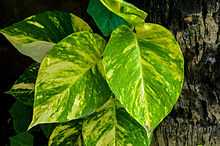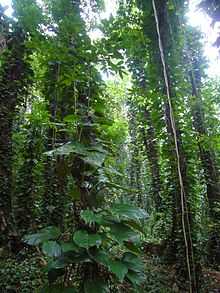Epipremnum aureum
| Epipremnum aureum | |
|---|---|
 | |
| Epipremnum aureum (Cultivar: Golden Queen) | |
| Scientific classification | |
| Kingdom: | Plantae |
| (unranked): | Angiosperms |
| (unranked): | Monocots |
| Order: | Alismatales |
| Family: | Araceae |
| Subfamily: | Monsteroideae |
| Tribe: | Monstereae |
| Genus: | Epipremnum |
| Species: | E. aureum |
| Binomial name | |
| Epipremnum aureum (Linden & André) G.S.Bunting, 1964 | |
| Synonyms[1] | |
| |


Epipremnum aureum is a species of flowering plant in the family of Araceae, native in Mo'orea, French Polynesia. The species has become naturalised in tropical and sub-tropical forests worldwide, include Northern Australia through Southeast Asia, India, Pakistan and as far as Hawaii and West Indies[2][3]. where it has caused severe ecological damage in some cases (see below). The plant has a multitude of common names including devil's ivy, golden pothos, hunter's robe, ivy arum, money plant, silver vine, Solomon Islands ivy and taro vine.
It is sometimes mistakenly labeled as a Philodendron in plant stores.
Characteristic
E. aureum is an evergreen vine growing to 20 m (66 ft) tall, with stems up to 4 cm (2 in) in diameter, climbing by means of aerial roots which adhere to surfaces. The leaves are alternate, heart-shaped, entire on juvenile plants, but irregularly pinnatifid on mature plants, up to 100 cm (39 in) long and 45 cm (18 in) broad (juvenile leaves much smaller, typically under 20 cm (8 in) long). The flowers are produced in a spathe up to 23 cm (9 in) long. This plant produces trailing stems when it climbs up trees and these take root when they reach the ground and grow along it. The leaves on these trailing stems grow up to 10 cm (4 in) long and are the ones normally seen on this plant when it is cultivated as a pot plant.
Cultivation and uses
In temperate regions it is a popular houseplant with numerous cultivars selected for leaves with white, yellow, or light green variegation. It is often used in decorative displays in shopping centers, offices, and other public locations largely because it requires little care and is also attractively leafy. It is also efficient at removing indoor pollutants such as formaldehyde, xylene, and benzene.[4] A study found that this effect lessened the higher the molecular weight of the polluting substance.[5] As a houseplant it can reach a height of 20 m (66 ft) or more, given suitable support. It has gained the Royal Horticultural Society's Award of Garden Merit.[6]
The plant is sometimes used in aquariums, placed on top of the aquarium and allowed to grow roots in the water. This is beneficial to the plant and the aquarium as it absorbs many nitrates and uses them for growth.
Toxicity
The plant is listed as "toxic to cats, toxic to dogs" by the ASPCA, because of the presence of insoluble raphides. Care should be taken to ensure the plant is not consumed by pets. Symptoms may include oral irritation, vomiting, and difficulty swallowing.[7]
Invasive Species
E. aureum can become a highly invasive species when introduced into tropical countries where it is not native. In Sri Lanka it overgrows several hectares of the Udawatta Kele Sanctuary in Kandy.[8] Having no natural enemies, it completely overgrows the forest floor as well as the trunks of trees, causing severe ecological disruption.
It also invades the Kurulukele Forest Reserve in Kegalla and other places where it has been planted as a decorative plant, or to hold steep banks along roads. It is on the USDA list for Florida Exotic Pest Control Council list 1999 as an invasive species.,[9]
See also
- Jade plant (also referred to as "money tree")
- Annual honesty (also referred to as "money plant")
References
- ↑ Epipremnum aureum (Linden & André) G.S.Bunting. In: The Plant List (2013). Version 1.1. Published on the Internet; http://www.theplantlist.org/ [2015-2-28].
- ↑ Epipremnum aureum. In: Govaerts, R. (2015). World Checklist of Araceae. Facilitated by the Royal Botanic Gardens, Kew. Published on the Internet; http://apps.kew.org/wcsp/ Retrieved 2015-2-28.
- ↑ Epipremnum aureum (Linden & André) G.S.Bunting. In: USDA, ARS, National Genetic Resources Program. Germplasm Resources Information Network - (GRIN) [Online Database]. National Germplasm Resources Laboratory, Beltsville, Maryland. URL: http://www.ars-grin.gov/cgi-bin/npgs/html/taxon.pl?461402 (28 February 2015)
- ↑ Wolverton, B. C. How To Grow Fresh Air, Penguin Books, New York, 1997.
- ↑ Ayako Sawada, Takashi Oyabu, Purification characteristics of pothos for airborne chemicals in growing conditions and its evaluation, Atmospheric Environment, Volume 42, Issue 3, January 2008, Pages 594-602, ISSN 1352-2310, doi:10.1016/j.atmosenv.2007.10.028.
- ↑ "Epipremnum aureum ". Royal Horticultural Society. Retrieved 25 July 2013.
- ↑ "Devils Ivy". ASPCA.org. Retrieved 2009-03-11.
- ↑ "'W. De Costa, H. Hitanayake and I. Dharmawardena, "A Physiological Investigation into the Invasive Behaviour of Some Plant Species in a Mid-Country Forest Reserve in Sri Lanka"" (PDF). JNSFSL, 2001, 29 (1 & 2):35–50. Retrieved 2009-03-11.
- ↑ USDA Natural Resources Conservation Service). Plants Profile
External links
| Wikispecies has information related to: Epipremnum aureum |
| Wikimedia Commons has media related to Epipremnum aureum. |
- Pothos Production Guide - discusses care of this plant
- TED video - Kamal Meattle on How to Grow Your Own Fresh Air slides